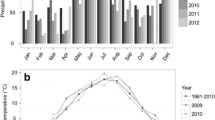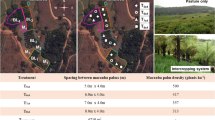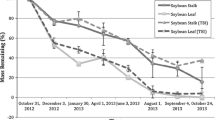Abstract
During the spring of 2006, three willow varieties (SV1, SX67 and 9882-41) were established on marginal land in an agroforestry tree-intercropping arrangement where plots of short rotation willows were planted between rows (spaced 15 m apart) of 21-year-old mixed tree species. As a control, the same varieties were established on an adjacent piece of land without established trees (conventional willow system). This study investigated the magnitude of carbon pools, fine root and leaf biomass inputs and clone yields in both the tree-based intercropping (agroforestry) and conventional monocropping systems. Willow biomass yield was significantly higher in the agroforestry field (4.86 odt ha−1 y−1) compared to the conventional field (3.02 odt ha−1 y−1). In both fields, varieties SV1 and SX67 produced higher yields than the variety 9882-41. Willow fine root biomass in the top 20 cm of soil was significantly higher in the intercropping system (3,062 kg ha−1) than in the conventional system (2,536 kg ha−1). Differences in fine root biomass between clones were similar to that observed for differences in biomass yield: SV1 > SX67 > 9882-41. Leaf input was higher in the intercropping system (1,961 kg ha−1) than in the conventional system (1,673 kg ha−1). Clonal differences in leaf inputs followed the same trends as those for root biomass and yield: SV1 > SX67 > 9882-41. Soil organic carbon was significantly higher in the agroforestry field (1.94 %) than in the conventional field (1.82 %). A significant difference in soil organic carbon was found between the three clones: soils under clone 9882-41 had the lowest soil organic carbon at 1.80 %.




Similar content being viewed by others
References
Abrahamson LP, Volk TA, Smart LB and Cameron KD (2010) Srub willow producer’s handbook, State University of New York http://www.esf.edu/willow/documents/ProducersHandbook.pdf Senior Research Associate. Accessed 04 Sep 2012
Carter MR, Gregorich EG (2008) Soil sampling and methods of analysis, 2nd edn. Canadian Society of Soil Science, CRC Press, Boca Raton, pp 228–229
Clinch RL (2008) Growing short-rotation woody crops in a tree-based intercropping system in southern Ontario. Dissertation, University of Guelph
Clinch RL, Thevathasan NV, Gordon AM, Volk TA, Sidders D (2009) Biophysical interactions in a short rotation willow intercropping system in southern Ontario, Canada. Agric Ecosyst Environ 131:61–69
Dickman DI, Pregitzer KS (1992) The structure and dynamics of woody plant systems. In: Mitchell CP, Ford JB, Hinckley T, Sennerby-Forsse L (eds) Ecophysiology of Short Rotation Forest Crops. Elsevier, London, pp 95–123
Dupraz C, Liagre F (2008) Agroforesterie - Des arbres et des cultures. Editions France Agricole, France
Friend AL, Scarascia-Mugnozza G, Isebrands JG, Heilman PE (1991) Quantification of two-year-old hybrid poplar root systems : morphology, biomass, and 14C distribution. Tree Physiol 8:109–119
Gordon AM, Newman SM (1997) Temperate agroforestry systems. CAB International Press, Wallingford
Heilman PE, Ekuan G, Fogle D (1994) Above- and below-ground biomass and fine roots of 4-year-old hybrids of Populus trichocarpa × Populus deltoides and parental species in short rotation culture. Can J For Res 24:1186–1192
Lund RE (1975) Tables for approximate test for outliers in linear models. Technometrics 17:473–476
Ong CK, Huxley P (1996) Tree-crop interactions: a physiological approach. CAB International, Wallingford
Peichl M, Thevathasan NV, Gordon AM, Huss J, Abohassan RA (2006) Carbon sequestration potentials in temperate tree-based intercropping systems, southern Ontario, Canada. Agrofor Syst 66:243–257
Picchi G, Gordon AM, Thevathasan NV (2006) Feedstock to furnace: bioenergy systems for the Ontario greenhouse industry. Misc. report, School of Environmental Sciences, University of Guelph
Reynolds PE, Simpson JA, Thevathasan NV, Gordon AM (2007) Effects of tree competition on corn and soybean photosynthesis, growth, and yield in a temperate tree-based agroforestry intercropping system in southern Ontario, Canada. Ecol Eng 29:362–371
Thevathasan NV, Gordon AM (2004) Ecology of tree intercropping systems in the north temperate region: experiences from southern Ontario, Canada. Agrofor Syst 61:257–268
Author information
Authors and Affiliations
Corresponding author
Rights and permissions
About this article
Cite this article
Cardinael, R., Thevathasan, N., Gordon, A. et al. Growing woody biomass for bioenergy in a tree-based intercropping system in southern Ontario, Canada. Agroforest Syst 86, 279–286 (2012). https://doi.org/10.1007/s10457-012-9572-y
Received:
Accepted:
Published:
Issue Date:
DOI: https://doi.org/10.1007/s10457-012-9572-y




